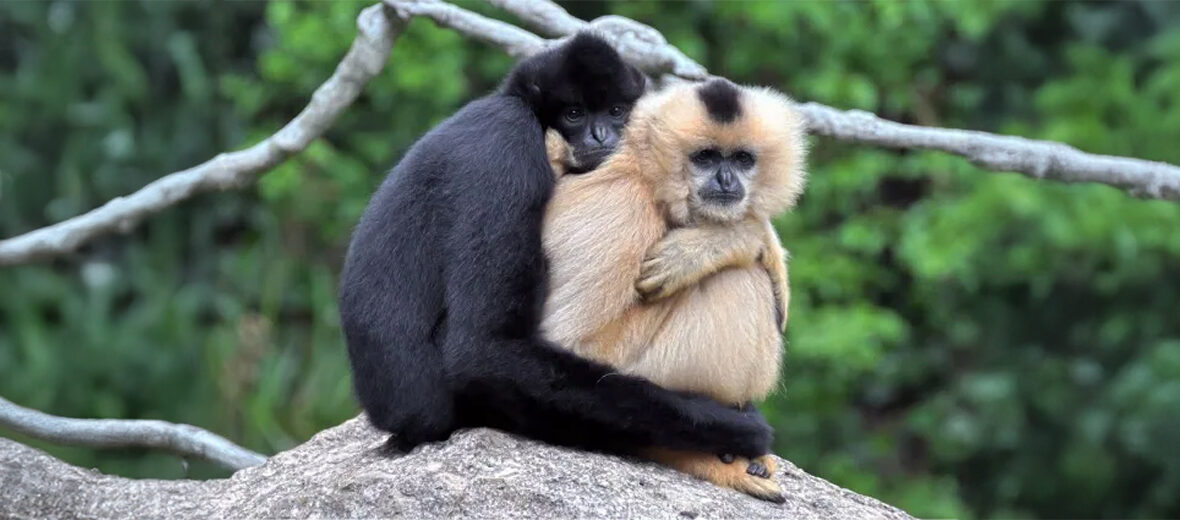
The Hainan black crested gibbon, aka Hainan gibbon, is only found on Hainan Island, in the South China Sea. They were formerly considered a subspecies of the eastern black crested gibbon from Hòa Bình and Cao Bằng provinces of Vietnam, and Jingxi County in Guangxi Zhuang Autonomous Region, China. However, molecular data, together along with morphology and differences in their calls, suggest they are a separate species. These primates face the threats of habitat loss and destruction at the hands of farming, logging, and gathering of plants; hunting; trapping; and human intrusion interfering with their breeding. The IUCN lists these gibbons as Critically Endangered as well as Critically Depleted. For now their population trend is listed as stable, but their future is definitely uncertain.
First the Stats…
Scientific name: Nomascus hainanus
Weight: Up to 22 lbs.
Length: Up to 19.3 inches
Lifespan: Up to 55 years
Now on to the Facts!
1.) Back in the 1950s, more than 2,000 gibbons were found throughout Hainan Island, a study in 2003 found only 13 total gibbons split into 2 groups and 2 lone males, and in 2004 only 12 – 19 Hainan gibbons were found solely in the Hainan Bawangling National Nature Reserve.
2.) The most recent assessment found 22 Hainan gibbons split between 2 families, 1 of 11 and 1 of 7 members, with 4 loners, all residing in Bawangling National Nature Reserve on Hainan Island.
3.) Over 25% of these gibbon’s habitat has been destroyed due to illegal pulp paper plantation growers.
4.) The 28+ inch long arms are used to swing from tree to tree, aka brachiation.
5.) These gibbons sing duets during their courtship time.
But wait, there’s more on the Hainan black crested gibbon!
6.) The few remaining gibbons display polygynous (1 male has multiple female partners) relationships; small families typically consist of 1 breeding male, 2 mature females, and their offspring. This stable pair bond relationship seems to have provided the gibbons the ability to decrease their interbirth interval (the length of time between births).
7.) Their 2-year interbirth interval is actually shorter than that of most gibbon species and correlates with the blooming patterns of the fruiting plants on the Hainan Islands.
Did you know…?
As it stands now, these gibbons are currently subject to being eliminated by a single major storm or disease epidemic!
8.) Females undergo up to a 24 week gestation (pregnancy) that yields a single infant.
9.) Their preferred habitats are primary forests, secondary forests, and dwarf forests.
10.) The human population on Hainan exploded by 330% between 1950 – 2003. Most of this was due to the open door policy implemented by the Chinese government in the late 1980s. Naturally, the population boom gave way to the construction of roads and towns to accompany the developing rubber and timber industry.
But wait, there’s still more on the Hainan black crested gibbon!
11.) Most of these projects led not only to the destruction of these primate’s habitat, but also caused gibbon populations to divide and become isolated from other troops.
12.) In addition to the economic development brought about by the growing population, there is financial desire to capture gibbons, since a female gibbon can be worth up to $300.
Did you know…?
There are presently no Hainan gibbons in captivity and all previous attempts to breed them in captivity have unfortunately failed.
13.) Gibbon bones are sadly also prized in traditional medicine and this belief led to many mass hunts between 1960 – 1980, leading to the death of around 100 gibbons.
14.) These primates feast on ripe, sugar-rich fruit, like figs, myrtle, and sometimes leaves and insects.
15.) In response to the ever-decreasing population of Hainan gibbons, a collective status survey and conservation plan was published in 2003 and updated in 2005. The survey was supporterd by members of the Hainanese and mainland Chinese governments, Kadoorie Conservation China, Fauna and Flora International (FFI), and other international institutions.
Now a Short Hainan Black Crested Gibbon Video!
Be sure to share & comment below! Also, check out the Critter Science YouTube channel. Videos added regularly!

Want to suggest a critter for me to write about? Let me know here.
Some source material acquired from: Wikipedia & IUCN
Photo credit: Palm Oil Detectives



